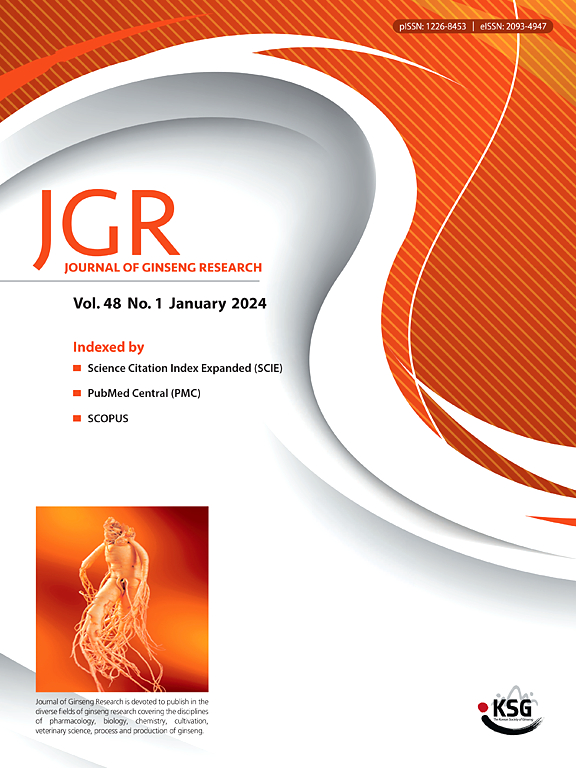人参皂苷Rg5通过调控GPVI信号通路和氯化铁诱导血栓形成抑制血小板聚集
IF 5.6
2区 医学
Q1 CHEMISTRY, MEDICINAL
引用次数: 0
摘要
背景:血小板过度活化是血栓性并发症(如心肌梗死和缺血性卒中)的主要因素。人参皂苷Rg5是一种次要的人参皂苷,在其多种有益药理作用中,其抗血栓潜力尚未得到广泛研究。方法分离人血小板,用Rg5 (35 ~ 100 μM)处理,再用胶原蛋白、凝血酶、U46619等激动剂刺激。评估血小板聚集、颗粒分泌、钙动员、血栓素A2产生、纤维蛋白原结合和凝块缩回。通过Western blot分析Rg5对关键蛋白信号通路的影响。在体内,用氯化铁(FeCl3)诱导的小鼠血栓形成来评估抗血栓疗效。结果与凝血酶和U46619相比,rg5对胶原诱导的血小板聚集具有剂量依赖性抑制作用(IC50 = 42.5 μM),选择性抑制gpvi介导的信号传导。Rg5抑制细胞内钙动员、颗粒分泌和凝血素A2的产生,未观察到细胞毒性。Rg5下调关键信号蛋白(p-PI3K、p-AKT、p-cPLA2和p-p38),上调p-VASP (S157和S239),提示其在提高环核苷酸信号传导中的作用。此外,Rg5抑制胶原蛋白和氧化低密度脂蛋白诱导的CD162表达。它还能阻止纤维蛋白原和纤维连接蛋白的结合,并显著减少凝块缩回。在体内,Rg5 (20 mg/kg)显著延长颈动脉闭塞时间,防止血栓形成,优于阿司匹林(100 mg/kg)。结论人参皂苷Rg5通过选择性靶向gpvi介导的血小板活化和调节关键的细胞内信号通路,具有较强的抗血小板活性。这些结果表明,Rg5可用于开发更安全的天然抗血小板疗法。本文章由计算机程序翻译,如有差异,请以英文原文为准。

Ginsenoside Rg5 inhibits platelet aggregation by regulating GPVI signaling pathways and ferric chloride-induced thrombosis
Background
Platelet hyperactivation is a major factor in thrombotic complications such as myocardial infarction and ischemic stroke. Ginsenoside Rg5 is a minor ginsenoside, and among its various beneficial pharmacological effects, its antithrombotic potential has not been extensively studied.
Methods
Human platelets were isolated and treated with Rg5 (35-100 μM) before stimulation with agonists such as collagen, thrombin, and U46619. Platelet aggregation, granule secretion, calcium mobilization, thromboxane A2 production, fibrinogen binding, and clot retraction were evaluated. The effects of Rg5 on signaling pathways were determined via Western blot analysis of key proteins. In vivo, the antithrombotic efficacy was assessed using ferric chloride (FeCl3)-induced thrombosis in mice.
Results
Rg5 dose-dependently inhibited collagen-induced platelet aggregation (IC50 = 42.5 μM) and selectively inhibited GPVI-mediated signaling compared to thrombin and U46619. Rg5 suppressed intracellular calcium mobilization, granule secretion, and thromboxane A2 production, with no cytotoxicity observed. Rg5 downregulated key signaling proteins (p-PI3K, p-AKT, p-cPLA2, and p-p38) while upregulating p-VASP (S157 and S239), suggesting its role in elevating cyclic nucleotide signaling. Additionally, Rg5 inhibited CD162 expression that was induced in the presence of collagen and oxidized low-density lipoprotein. It also prevented fibrinogen and fibronectin binding and significantly reduced clot retraction. In vivo, Rg5 (20 mg/kg) significantly prolonged the carotid artery occlusion time and prevented thrombus formation, outperforming aspirin (100 mg/kg).
Conclusion
Ginsenoside Rg5 exhibits potent antiplatelet activity by selectively targeting GPVI-mediated platelet activation and modulating key intracellular signaling pathways. These results suggest that Rg5 could be utilized to develop safer and natural antiplatelet therapies.
求助全文
通过发布文献求助,成功后即可免费获取论文全文。
去求助
来源期刊

Journal of Ginseng Research
CHEMISTRY, MEDICINAL-INTEGRATIVE & COMPLEMENTARY MEDICINE
CiteScore
11.40
自引率
9.50%
发文量
111
审稿时长
6-12 weeks
期刊介绍:
Journal of Ginseng Research (JGR) is an official, open access journal of the Korean Society of Ginseng and is the only international journal publishing scholarly reports on ginseng research in the world. The journal is a bimonthly peer-reviewed publication featuring high-quality studies related to basic, pre-clinical, and clinical researches on ginseng to reflect recent progresses in ginseng research.
JGR publishes papers, either experimental or theoretical, that advance our understanding of ginseng science, including plant sciences, biology, chemistry, pharmacology, toxicology, pharmacokinetics, veterinary medicine, biochemistry, manufacture, and clinical study of ginseng since 1976. It also includes the new paradigm of integrative research, covering alternative medicinal approaches. Article types considered for publication include review articles, original research articles, and brief reports.
JGR helps researchers to understand mechanisms for traditional efficacy of ginseng and to put their clinical evidence together. It provides balanced information on basic science and clinical applications to researchers, manufacturers, practitioners, teachers, scholars, and medical doctors.
 求助内容:
求助内容: 应助结果提醒方式:
应助结果提醒方式:


